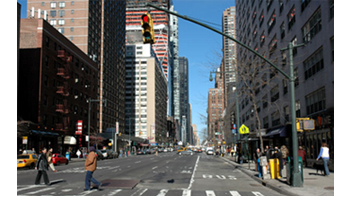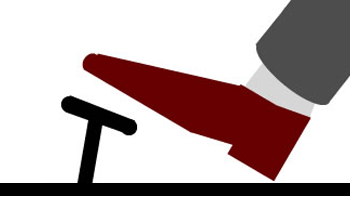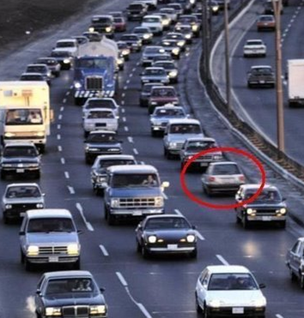Driving in the city typically involves many cars, pedestrians, busses and bicyclists. On top of these potential hazards, city driving can involve one-way streets and people pulling out from parking spots.
While driving in the city you should be prepared. One way to do this is to reduce your speed so that you may be able to see roadway details and be able to identify hazards. You should not drive so fast that you cannot interpret signs, see lights, and watch for trouble areas. Speeds of 15-25 mph are typically safe in the city.
You should also reduce your speed so that you may anticipate what may happen. Slow down to read, see and understand the meaning of the signals and signs. Drive slow enough to make good decisions, allowing enough reaction time to make maneuvers safely and without incident. Apply the three-second rule which will allow a large enough space cushion between you and the vehicle you are following. Cover your brake and be prepared for hazards.

12.2.1 Signal Lights
While driving in the city, look 10-15 seconds ahead, so you are prepared for signal lights and possible problems in intersections. If the light ahead has been green for some time, you should be prepared for the light to change to yellow or red. Watch the intersection pedestrian signals to determine where the signal cycle is up ahead. If you look down the road you will know whether to stop or slow down ahead.
Situations in Which the Brake Pedal Should Be Covered
- When you are driving next to parked vehicles because a vehicle might pull out unexpectedly or a person might step out of his or her car. Additionally, a vehicle may pull unexpectedly out of an intersection or pedestrians may be stepping out into the street but you cannot see them in time because you are watching the parked cars.
- When you see brake lights turn on in front of you, don’t accelerate. This means ANY brake light, even one several cars in front of you. If someone in front of you is braking, that does not mean that you too must brake (at least not yet), but it does mean that you should not be accelerating toward the slowing car! Prepare yourself to stop by covering your brake pedal when you see additional vehicles in front of you braking. This is usually a very good indication that you will also have to slow or stop eventually. Covering the brake pedal allows you to brake smoother, where otherwise you may over-react and “slam” down on the brake pedal.
- When approaching any intersection, whether it is controlled or not. You need time to evaluate the cross traffic and the on-coming traffic that might cross your path. If your foot is on alert, the rest of you will be too. By covering your brake pedal you will be prepared to react to any emergency situation

12.2.2 Choosing the Best Lane
Know ahead of time where you are going and the route you will need to take to get there, so you are able to plan which lane you should be in. Be in the appropriate lane for any maneuver. If you are going slowly, you should stay in the right lane. If passing, you should pass and then move your vehicle back into the safest lane. Do not drive in the left (also called the passing) lane if you are driving slower than traffic around you; this blocks traffic in the passing lane.
Avoid the Right Lane on a Busy City Street
If you are traveling down a city street that has three lanes in the same direction, avoid the right lane unless you are planning a right turn at the corner or into a parking lot. In the right lane of a city street, vehicles fluctuate their speed more than in the other lanes. Vehicles are continually slowing for turning vehicles, doors opening, pedestrians, etc. If the only other choice on a busy city street is the left lane, keep an eye on your rear-view mirror and move to the right if you are slowing down traffic while driving in the left lane. Be sure to signal at least 100 feet in advance if you are planning to make a turn out on the road.
Public Transit Bus Lanes
It is illegal to drive, stop, park, or leave a vehicle standing in the area of a road designated for the exclusive use of public transit buses unless a vehicle must cross the lane to make a turn. Signs will be posted to indicate the lanes are for “bus only” use (CVC §21655.1)
12.2.3 Choosing a Safe Route
Time of Day and Traffic Density
Learn the busiest times to travel and the most congested routes and streets on your local roadways, so you can avoid traveling at those times and on those routes. If it is necessary to drive during these hours, be prepared to go slow, allow more space, and allow much more time to get to your destination.
Through Streets vs. Side Streets
Through streets are designed for larger flows of traffic that are traveling at a faster and more direct route. Side streets are for people who are going into residential and business areas, so there is more slower-moving and less-consistent traffic, making side streets a more dangerous route to travel. When at all possible, use through traffic routes; you will arrive at your destination faster and in one piece.
12.2.4 Driving On One-Way Streets
One-way streets are often found in downtown areas. Many drivers are completely unaware that they are entering into a one-way street, because they did not pay attention to the traffic signs which indicated a one-way street. On one-way streets, all of the traffic lanes on the street are flowing in one direction, and all separating lines are white. You must identify a one-way street before entering; look for signs that indicate that it is a one-way street.
Upon entering a one-way street you must first check the flow of traffic. If you are entering a one-way street from a left turn on a two-way street, remember that the lane closest to you (the left lane, lane one) on the one-way street is the safest lane to enter (though all lanes are legal, if safe).
Right turns onto one way streets are similar to turning right on a normal traffic lane, though turning only into the right-hand lane is not required, just safer. Be sure to stay in your lane if multiple lanes are turning.
As always, when driving on a one-way street you must obey the posted speed limit. If you are traveling on a one-way alley, the speed limit is usually 15 mph. Otherwise the speed will be posted on either side of the road facing the one-way driver.
Dealing With Wrong Way Drivers
The flow of traffic on one-way streets is usually much smoother. Be aware of drivers who are unaware that they are entering a one-way street; these drivers may not realize their mistake until they are already traveling in the wrong direction. Wrong-way drivers typically drive in the right (your left) side of the one way street, so cover your brake and avoid the far left lane of the one-way street if you see an oncoming car.

12.2.5 Special Problems Associated With City Traffic
Parked Cars Hiding Cross-Traffic
When you are approaching an intersection, you must have a complete view of the traffic in all directions. If there are parked vehicles obstructing your view of the intersection, you should slow down to anticipate any hazards and so you can see the path is clear and safe for you to continue. Cover your brake as you approach the intersection, just in case you must brake suddenly.
Two-Way Left Turn Center Lane Use
A two-way, left turn lane or a center left turn lane is in the middle of a two-way street and is marked on both sides by two painted lines: outside yellow solid lines and inside broken yellow lines. You must use this lane when beginning or ending left-hand turns on the street. You may drive for up to 200 feet in one of these lanes, but it is never a passing lane, and it is not a regular traffic lane. Make sure that when you use this lane, your entire car pulls into this lane (all four wheels) and your car is parallel to the lines while waiting for the safe completion of your left turn into or out of traffic. You may drive across a center left-hand-turn lane, if safe.
Turning At Corners
When you are turning at a corner you should be aware of any cross traffic, pedestrians, bicyclists, and prohibitive signs. Make certain that the crosswalk is clear and free of all pedestrians and vehicles before you begin your turn.



